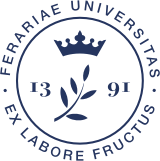Patrocini
Perchè siamo importanti, perchè siamo istituzionali.
Prof. Barbara Zavan is an international scientist head of Research group in Traslational Medicine in University of Ferrara. Research Group of Prof. Zavan work from several years works in Intercellular Wireless Communications in microgravity with the use of Exosomes.Exosomes are nanoscale membrane-bound extracellular vesicles secreted by most eukaryotic cells in the body that facilitates intercellular communication.
Exosomal contents including micro-RNA have emerged as key regulators of target cell biology and function. Exosomes carry several signaling biomolecules, including miRNA, proteins, enzymes, cell surface receptors, growth factors, cytokines and lipids that can modulate target cell biology and function. Exosome membranes are made of a lipid bilayer and reflect the cells of origin; for example, exosomes from immune cells will have either MHC or T-cell receptor or B-cell receptor molecules whereas exosomes from cardiac progenitor cells express CD73/CD90/CD105 .
However, the contents of exosomes are actively sorted and may or may not reflect the molecules from the cells of origin. For example, certain miRNA are selectively sorted into exosomes and these may potentially be absent in parent cells .
The contents of the exosomes can reprogram the target cells by activating specific signaling pathways via binding to specific receptors or through the delivery of enzymes and transcriptional regulators. Due to these capabilities, exosomes have emerged as novel intercellular signaling mediators in both homeostasis and pathophysiological conditions. Several studies document that exosomes have been actively involved in several tissue remodeling in response to stressors such as heart, kidney, pancreas, bone.
Also, exosomes released from stem cells have protective effects in several diseases. Currently, exosomes are referred to as EVs of endosomal origin with a diameter of 50–150 nm. Exosome precursors are intraluminal vesicles (ILVs), generated by the inward budding of discrete domains of the membrane of early endosomes, subsequently evolving into multivesicular bodies (MVBs)]. under appropriate stimulation, MVBs can move towards the plasma membrane to undergo exocytic fusion followed by release of their ILVs (i.e., exosomes) into the extracellular space.
Once released, EVs navigate the extracellular space and reach target cells to regulate physiological (e.g., organismal development, immune response, neuronal communication, tissue repair) or pathological processes (e.g., tumor and neurodegenerative disease progression ).In light of such consideration we can assume that external stimuli, such as absence or presence of microgravity, could strongly influence both the content or the superficial marker (and then the final destination) of the exosomes.
Aim of the purpose project is to analyze in content and superficial markers exosomes derived from different cell population (the mainly involved on tissue repair-regeneration or in cancer) namely: mesenchymal stem cells, endothelial cells, cardiomyocytes, glial cells, macrophages, fibroblast, astrocytes, cancer cells. Cells will be cultured both in monolayer and in 3D (by means of 3D biopriner) conditions)Exosomes will we characterizer by means of cytofluorimetry, TEM; quantity and size distribution, content with molecular biology techniques.
Moreover Prof. Zavan collaborate from several years with Marco Scatto as scientist involved in active polymer materials in order to realize Active Polymers compound with specific biologically properties, very interesting in earth applications. Antimicrobial, antifungal activities are reached thanks to the possibility to mixed specific pharmaceutical ingredients with thermoplastic polymer. With these active polymer compounds is possible to realize polymer parts by traditional processing or by additive manufacturing. The possibility to study the behavior of active polymer compound in microgravity open the way to application of innovative polymer materials in ISS environment where microbial growth in huge condition generates critical life condition.
Qui puoi visualizzare gli appuntamenti, i workshop e/o gli eventi organizzati dall’espositore all’interno della manifestazione.
